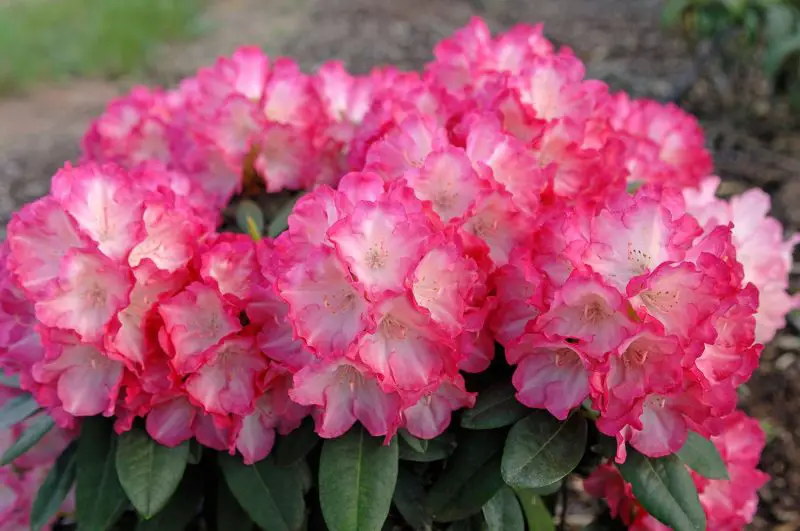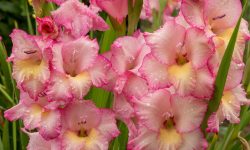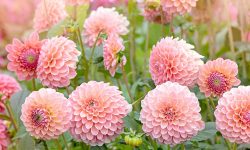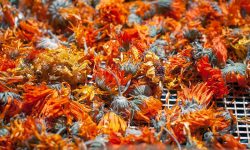Rhododendrons are stunning flowering shrubs admired for their vibrant blooms. Their large, colorful flowers and glossy leaves make them a favorite in gardens worldwide. However, successful planting requires understanding their unique needs.
These plants thrive in acidic, well-drained soil and partial shade. Knowing how to prepare the soil, select the right location, and care for young plants ensures healthy growth and abundant blooms. With proper techniques, even beginners can enjoy thriving rhododendrons.
Choosing the Right Location

Sunlight Requirements
Rhododendrons thrive in partial shade, where they receive filtered sunlight throughout the day. Direct, intense sunlight can scorch leaves, causing browning and reducing flowering potential. Morning sun with afternoon shade is ideal, particularly in hot climates, as it allows sufficient light without stressing the plant.
Too little sunlight can also hinder growth. Shady locations often result in leggy plants with fewer and smaller blooms. Observing your garden at different times of the day helps identify the best planting spot. Choose areas where sunlight is balanced, ensuring flowers develop fully and leaves remain healthy.
Consider natural or artificial shade if your garden receives harsh afternoon sun. Trees or pergolas can provide filtered light, protecting delicate leaves while allowing rhododendrons to thrive. Proper sunlight exposure is critical for photosynthesis, energy production, and overall plant vigor.
Soil and Drainage
Rhododendrons prefer well-drained, acidic soil with a pH of 4.5–6.0. Waterlogged or compacted soil can cause root rot and hinder nutrient absorption, stunting growth. Ensuring proper drainage is crucial for long-term health.
Amend heavy clay or sandy soils with organic matter, such as compost, peat moss, or leaf mold. This improves soil structure, retains moisture without waterlogging, and maintains the acidic conditions rhododendrons require. Raised beds or mounds are effective in areas prone to poor drainage.
Regularly checking soil moisture ensures the plant receives enough water without overwatering. Mulching with pine bark or needles further helps retain moisture, regulate temperature, and prevent weed growth. Proper soil and drainage create a strong foundation, allowing rhododendrons to establish quickly and bloom abundantly.
Selecting Healthy Plants
Inspecting the Roots
When selecting rhododendrons, healthy roots are essential for rapid establishment. Look for firm, white or light-colored roots without blackened or dry sections. Damaged roots indicate poor health and may hinder growth.
Gently examine the root ball before planting. Ensure it is moist and free of pests or fungal infections. Roots should be evenly distributed, not tightly circling the container. This allows them to spread easily in the garden soil.
Healthy roots absorb nutrients efficiently, supporting strong stems, lush foliage, and abundant blooms. Plants with robust roots are more resilient to environmental stress and adapt faster to new locations. Prioritizing root health reduces transplant shock and increases long-term success.
Choosing the Right Variety
Select a rhododendron variety suited to your local climate. Some types tolerate colder winters, while others prefer milder, frost-free areas. Choosing a variety compatible with your region increases survival rates and flowering potential.
Consider flower color, bloom size, and growth habit. Compact varieties suit small gardens, while larger shrubs provide dramatic focal points. Consult nursery labels or local horticulturists to identify plants proven to thrive in your area.
Matching variety to location ensures optimal growth and long-lasting beauty. The right choice reduces stress, improves disease resistance, and enhances the overall garden aesthetic. Careful selection is the first step toward successful rhododendron cultivation.
Preparing the Planting Site
Clearing and Preparing Soil
Before planting rhododendrons, remove weeds, rocks, and debris from the selected area. This prevents competition for nutrients and water. Clearing the site ensures the plant establishes quickly and thrives.
Loosen the soil to a depth of 12–18 inches, allowing roots to grow freely. Incorporate organic matter such as compost, peat moss, or well-rotted leaf mold. This improves soil structure, fertility, and moisture retention, creating optimal conditions for young plants.
Test soil pH before planting. Rhododendrons prefer acidic soil with a pH of 4.5–6.0. If necessary, adjust acidity using elemental sulfur or acidic compost. Proper soil preparation minimizes transplant shock and sets the foundation for healthy growth and abundant flowering.
Creating the Planting Hole
Dig a hole slightly wider than the root ball but no deeper than its height. Rhododendron roots are shallow, so planting too deep can suffocate them and stunt growth.
Place the plant carefully in the hole, spreading roots gently to avoid bending or crowding. Fill around the roots with amended soil, keeping the crown level with the surrounding ground. Lightly firm the soil and water thoroughly to remove air pockets.
Planting correctly reduces stress and encourages strong root development. Proper hole preparation combined with well-amended soil ensures rhododendrons adapt quickly and bloom beautifully in their new location.
Planting Techniques
Proper Planting Depth
Planting rhododendrons at the correct depth is essential to prevent root rot and promote healthy growth. The top of the root ball should align with the surrounding soil. Planting too deep limits oxygen to roots, while planting too shallow can expose roots to drying out.
Gently firm soil around the root ball, ensuring good contact without compacting it excessively. This allows roots to expand easily and access nutrients. Proper planting depth encourages rapid establishment and reduces stress, improving survival rates in the first growing season.
Consider the plant’s growth habit when positioning it. Ensure adequate space between shrubs to avoid overcrowding. Correct planting depth combined with careful spacing supports long-term vigor, abundant flowering, and overall landscape aesthetics.
Watering During Planting
Watering immediately after planting is crucial to settle soil around the roots. Deep watering encourages roots to grow downward, establishing a strong foundation. Shallow watering can result in weak, surface-level roots.
Maintain consistent moisture for the first few weeks, adjusting for rainfall and temperature. Avoid waterlogging, which can suffocate roots and promote disease. Mulching around the base helps retain moisture, regulate soil temperature, and prevent weed growth.
Consistent, careful watering during the early stages helps reduce transplant shock and supports healthy leaf development. Proper hydration combined with optimal soil conditions ensures rhododendrons thrive and bloom beautifully in their new environment.
Mulching and Soil Care
Benefits of Mulching
Mulching rhododendrons protects shallow roots from temperature fluctuations and conserves soil moisture. It creates a stable environment for growth. Organic mulches like pine bark, pine needles, or leaf mold also help maintain acidic soil conditions, which rhododendrons prefer.
Apply 2–3 inches of mulch around the base, keeping it a few inches away from the stem to prevent rot. As mulch decomposes, it improves soil fertility and structure, providing nutrients and enhancing drainage. Mulching also suppresses weeds, reducing competition for water and nutrients.
Regular mulching supports long-term plant health. It minimizes stress during hot summers or cold winters and encourages consistent flowering. By creating a protective layer over the soil, mulching helps rhododendrons thrive and maintain vibrant foliage throughout the year.
Soil Maintenance
Rhododendrons require acidic soil with adequate nutrients for optimal growth. Regularly test soil pH and amend if necessary using elemental sulfur or acidic compost. Maintaining the right pH ensures healthy root development and better flowering.
Use slow-release fertilizers formulated for acid-loving plants. Apply in early spring and after flowering to encourage new growth and vibrant blooms. Avoid over-fertilizing, which can damage roots and reduce flower production.
Consistent soil care enhances plant resilience and prevents common problems like chlorosis or weak growth. Monitoring soil moisture, acidity, and fertility ensures rhododendrons remain healthy, bloom abundantly, and thrive in your garden for many years.
Watering Tips
Frequency and Method
Rhododendrons require deep but infrequent watering. Shallow watering encourages weak, surface roots, reducing long-term plant stability. Deep watering promotes strong root development and overall health.
Water early in the morning to minimize evaporation and reduce the risk of fungal diseases. Avoid overhead watering, which can damage leaves and flowers. Drip irrigation or soaker hoses are ideal methods to provide consistent moisture directly to the root zone.
Adjust watering frequency based on rainfall, soil type, and temperature. Mulching helps retain moisture and reduces the need for frequent watering. Consistent, appropriate hydration ensures healthy growth and abundant flowering throughout the season.
Common Watering Mistakes
Overwatering rhododendrons can lead to root rot, leaf yellowing, and fungal issues. Underwatering causes stress, poor flowering, and stunted growth. Maintaining the right moisture balance is essential for plant health.
Newly planted rhododendrons need more frequent watering until they establish strong roots. Mature plants require less frequent but deep watering, especially during dry spells. Monitoring soil moisture with a finger test or soil probe can prevent over or underwatering.
Proper watering supports photosynthesis, nutrient uptake, and bloom development. Avoid extremes and combine watering with mulching to stabilize soil conditions. Correct techniques promote lush foliage, vibrant flowers, and long-lasting health.
Pruning and Maintenance
Timing for Pruning
Prune rhododendrons immediately after flowering. Removing spent blooms prevents seed formation and encourages more flowers next season. Proper timing preserves flower buds for the following year.
Focus on dead, damaged, or diseased branches. Removing these improves air circulation, reduces disease risk, and enhances overall plant shape. Avoid heavy pruning in late summer or fall, as this can reduce cold hardiness and stress the plant before winter.
Regular, timely pruning encourages compact growth and stronger stems. Properly maintained shrubs are more resilient to environmental stress and consistently produce vibrant, abundant flowers each season.
Fertilizing for Growth
Rhododendrons benefit from fertilizers formulated for acid-loving plants. Apply fertilizer in early spring and after flowering to support new growth and enhance bloom quality. Avoid over-fertilizing, which can damage roots and reduce flower production.
Slow-release fertilizers provide nutrients gradually, promoting steady, healthy growth. Complement fertilization with organic matter like compost or leaf mold to improve soil structure and moisture retention.
Balanced fertilization strengthens stems, improves leaf color, and ensures vigorous flowering. Combined with proper pruning, watering, and mulching, fertilizing helps rhododendrons thrive and maintain long-term beauty in the garden.
Pest and Disease Management
Common Pests
Rhododendrons are susceptible to pests like aphids, spider mites, and lace bugs. These insects feed on leaves and sap, weakening plants and reducing flowering. Early detection is essential for effective control.
Inspect leaves and stems regularly. Look for discoloration, stippling, or sticky residue, which indicate pest activity. Healthy, well-maintained plants are more resistant to infestations. Natural predators such as ladybugs can help control pests without chemicals.
If infestations persist, apply insecticidal soap or horticultural oil. Follow instructions carefully and avoid spraying during the hottest part of the day. Proper spacing and airflow between plants also prevent pest buildup and ensure long-term plant health.
Disease Prevention
Fungal diseases like root rot, leaf spot, and powdery mildew can affect rhododendrons. Poor drainage and overhead watering increase susceptibility to these conditions. Preventive care is key.
Ensure good soil drainage and avoid planting in low-lying, waterlogged areas. Remove and dispose of infected leaves promptly to prevent disease spread. Mulching and proper airflow reduce humidity around foliage, lowering fungal risk.
Fungicides may be used as a preventive measure in humid climates. Maintaining plant health, proper spacing, and attentive care significantly reduces the likelihood of pests and diseases. Healthy rhododendrons flourish and produce vibrant blooms consistently.
Seasonal Care
Spring and Summer
Spring is the critical season for rhododendron growth and flowering. Apply slow-release fertilizer formulated for acid-loving plants. This supports new growth and encourages vibrant blooms.
Water consistently, especially during dry spells, and mulch to retain soil moisture. Deadhead spent flowers to prevent seed formation and stimulate additional flowering. Regular monitoring for pests, like aphids and spider mites, is essential during warm months.
Summer care includes ensuring protection from harsh afternoon sun in hotter regions. Shade cloth or natural shade helps prevent leaf scorch. Maintaining soil moisture, mulching, and monitoring plant health ensure rhododendrons remain strong and continue blooming beautifully.
Fall and Winter
In fall, prepare rhododendrons for colder months by adding extra mulch around the root zone. This protects shallow roots from frost and temperature fluctuations. Remove dead leaves and debris to reduce disease risk.
Reduce watering in winter, as rhododendrons need less moisture during dormancy. Avoid heavy pruning in late summer or fall, as it can damage winter buds and reduce hardiness. Inspect plants for signs of pest or disease damage before winter sets in.
Proper fall and winter care ensures plants survive cold periods and are ready to produce healthy foliage and abundant flowers the following spring. Seasonal attention strengthens the plant, promotes resilience, and supports long-term garden beauty.
FAQ About How to Plant Rhododendron Successfully
How often should I water newly planted rhododendrons?
Newly planted rhododendrons need consistent moisture to establish roots. Water deeply 2–3 times per week, adjusting for rainfall and temperature. Avoid shallow watering, which encourages weak roots. Use mulch to retain moisture and prevent soil drying. Once established, reduce frequency but maintain deep watering during dry spells. Morning watering is ideal to reduce fungal risk and evaporation.
What type of soil is best for rhododendrons?
Rhododendrons thrive in acidic, well-drained soil with a pH of 4.5–6.0. Soil rich in organic matter promotes root growth and retains moisture without waterlogging. Amend heavy clay with compost or peat moss to improve drainage and acidity. Testing soil pH before planting ensures optimal conditions and healthier, more vibrant blooms.
Can rhododendrons grow in full sun?
Rhododendrons prefer partial shade, especially in hot climates. Morning sun with afternoon shade works best. Full sun may scorch leaves and reduce flowering, while deep shade can result in leggy growth and fewer blooms. Observing your garden’s sunlight patterns helps you select the best planting site for optimal growth.
How should I prune rhododendrons?
Prune rhododendrons immediately after flowering. Remove dead or damaged branches and shape the shrub. Avoid heavy pruning in late summer or fall to prevent reducing winter hardiness. Regular, timely pruning encourages new growth, improves air circulation, and preserves next year’s flower buds.
How can I prevent pests and diseases on rhododendrons?
Common pests include aphids, spider mites, and lace bugs. Inspect plants regularly and use insecticidal soap or horticultural oil if needed. Prevent fungal diseases by ensuring good drainage, avoiding overhead watering, and removing infected leaves promptly. Healthy plants, proper spacing, and attentive care reduce the risk of infestations and disease.
Conclusion
Planting rhododendrons successfully requires careful planning, proper soil preparation, and consistent care. Choosing the right location, selecting healthy plants, and following proper planting techniques ensures vibrant blooms. Mulching, correct watering, pruning, and seasonal maintenance support long-term health. Regular monitoring for pests and diseases prevents damage. By providing the ideal environment and attentive care, gardeners can enjoy thriving rhododendrons with stunning flowers that enhance any landscape. With patience and knowledge, these shrubs become a rewarding centerpiece for years.






